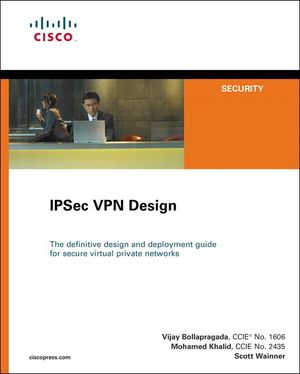Vi har bytt namn till Adlibris Campus! Campusbokhandeln ❤️ Adlibris - Läs mer här

IPSec VPN Design
- Inbunden, Engelska, 2005
- Författare: Vijay Bollapragada, Mohamed Khalid, Scott Wainner
- Betyg:
Ej i lager
Beskrivning
Introduction
Chapter 1 Introduction to VPNs
Motivations for Deploying a VPN
VPN Technologies
Layer 2 VPNs
Layer 3 VPNs
Remote Access VPNs
Summary
Chapter 2 IPSec Overview
Encryption Terminology
Symmetric Algorithms
Asymmetric Algorithms
Digital Signatures
IPSec Security Protocols
IPSec Transport Mode
IPSec Tunnel Mode
Encapsulating Security Header (ESP)
Authentication Header (AH)
Key Management and Security Associations
The Diffie-Hellman Key Exchange
Security Associations and IKE Operation
IKE Phase 1 Operation
IKE Phase 2 Operation
IPSec Packet Processing
Summary
Chapter 3 Enhanced IPSec Features
IKE Keepalives
Dead Peer Detection
Idle Timeout
Reverse Route Injection
RRI and HSRP
Stateful Failover
SADB Transfer
SADB Synchronization
IPSec and Fragmentation
IPSec and PMTUD
Look Ahead Fragmentation
GRE and IPSec
IPSec and NAT
Effect of NAT on AH
Effect of NAT on ESP
Effect of NAT on IKE
IPSec and NAT Solutions
Summary
Chapter 4 IPSec Authentication and Authorization Models
Extended Authentication (XAUTH) and Mode Configuration (MODE-CFG)
Mode-Configuration (MODECFG)
Easy VPN (EzVPN)
EzVPN Client Mode
Network Extension Mode
Digital Certificates for IPSec VPNs
Digital Certificates
Certificate Authority–Enrollment
Certificate Revocation
Summary
Chapter 5 IPSec VPN Architectures
IPSec VPN Connection Models
IPSec Model
The GRE Model
The Remote Access Client Model
IPSec Connection Model Summary
Hub-and-Spoke Architecture
Using the IPSec Model
Transit Spoke-to-Spoke Connectivity Using IPSec
Internet Connectivity
Scalability Using the IPSec Connection Model
GRE Model
Transit Site-to-Site Connectivity
Transit Site-to-Site Connectivity with Internet Access
Scalability of GRE Hub-and-Spoke Models
Remote Access Client Connection Model
Easy VPN (EzVPN) Client Mode
EzVPN Network Extension Mode
Scalability of Client Connectivity Models
Full-Mesh Architectures
Native IPSec Connectivity Model
GRE Model
Summary
Chapter 6 Designing Fault-Tolerant IPSec VPNs
Link Fault Tolerance
Backbone Network Fault Tolerance
Access Link Fault Tolerance
Access Link Fault Tolerance Summary
IPSec Peer Redundancy
Simple Peer Redundancy Model
Virtual IPSec Peer Redundancy Using HSRP
IPSec Stateful Failover
Peer Redundancy Using GRE
Virtual IPSec Peer Redundancy Using SLB
Server Load Balancing Concepts
IPSec Peer Redundancy Using SLB
Cisco VPN 3000 Clustering for Peer Redundancy
Peer Redundancy Summary
Intra-Chassis IPSec VPN Services Redundancy
Stateless IPSec Redundancy
Stateful IPSec Redundancy
Summary
Chapter 7 Auto-Configuration Architectures for Site-to-Site IPSec VPNs
IPSec Tunnel Endpoint Discovery
Principles of TED
Limitations with TED
TED Configuration and State
TED Fault Tolerance
Dynamic Multipoint VPN
Multipoint GRE Interfaces
Next Hop Resolution Protocol
Dynamic IPSec Proxy Instantiation
Establishing a Dynamic Multipoint VPN
DMVPN Architectural Redundancy
DMVPN Model Summary
Summary
Chapter 8 IPSec and Application Interoperability
QoS-Enabled IPSec VPNs
Overview of IP QoS Mechanisms
IPSec Implications for Classification
IPSec Implications on QoS Policies
VoIP Application Requirements for IPSec VPN Networks
Delay Implications
Jitter Implications
Loss Implications
IPSec VPN Architectural Considerations for VoIP
Decoupled VoIP and Data Architectures
VoIP over IPSec Remote Access
VoIP over IPSec-Protected GRE Architectures
VoIP Hub-and-Spoke Architecture
VoIP over DMVPN Architecture
VoIP Traffic Engineering Summary
Multicast over IPSec VPNs
Multicast over IPSec-protected GRE
Multicast on Full-Mesh Point-to-Point GRE/IPSec Tunnels
DMVPN and Multicast
Multicast Group Security
Multicast Encryption Summary
Summary
Chapter 9 Network-Based IPSec VPNs
Fundamentals of Network-Based VPNs
The Network-Based IPSec Solution: IOS Features
The Virtual Routing and Forwarding Table
Crypto Keyrings
ISAKMP Profiles
Operation of Network-Based IPSec VPNs
A Single IP Address on the PE
Front-Door and Inside VRF
Configuration and Packet Flow
Termination of IPSec on a Unique IP Address Per VRF
Network-Based VPN Deployment Scenarios
IPSec to MPLS VPN over GRE
IPSec to L2 VPNs
PE-PE Encryption
Summary
Index